What if you could get your morning coffee, go grocery shopping, see the doctor, and go to the gym all within a 15-minute walk from your home?
Cities are a site for global challenges, ranging from climate change to social inequalities. As urban populations continue to grow, there is an urgent need to rethink the way we design and manage our spaces. The concept of the “15-Minute City” has gained traction as a potential solution to many of these challenges. In a 15-Minute City, all essential services and amenities are within a 15-minute walk or bike ride from one’s home, making cities more sustainable, resilient, and liveable. Data plays a crucial role in the creation of these cities, providing insights, guiding decision-making, and ensuring their effectiveness.
What is a 15-minute city?
The 15-Minute City concept, popularized by the Colombian-French urban planner Carlos Moreno, is based on a central premise: create cities where everything a resident needs can be reached within a 15-minute walk or bike ride. This drives the shift in urban planning from the car-centric cities of the 20th century to prioritize pedestrians, cyclists, and public transportation, resulting in environmental, social, and economic benefits.

Environmental Benefits
The 15-Minute City can most notably be beneficial for its environmental impact. Urban processes typically contribute to environmental distress, especially through carbon emissions from car-dependent cities. Therefore, the concept of a 15-minute City where everything is accessible within these parameters clearly helps improve some of these impacts. Some examples of these benefits include:
- Improved Air Quality: Fewer cars on the road lead to improved air quality in cities, which also results in better health outcomes for residents.
- Preservation of Green Spaces: The 15-Minute City necessitates green spaces, parks, and gardens. This not only contributes to a higher quality of life but also supports biodiversity and urban cooling.
Social Benefits
Accompanied by the environmental advantages of a 15-minute city, the concept also comes with several social benefits. Improving the proximity of residents’ needs within walking distance in a neighborhood encourages greater community exposure and in turn social collaborations to further enhance the city. This can be seen through several advantages like:
- Enhanced Well-being: Reducing the time and stress associated with commuting, as well as promoting physical activity through walking and cycling, can have a positive impact on the well-being of city residents.
- Social Equity: By making essential services easily accessible, regardless of income or location, it reduces inequalities across social classes.
Economic Benefits
Accompanying the social benefits that are consequential to the 15-Minute City, it also can generate economic gain for the area. Some possible instances of this advantage can be seen in:
- Local Businesses: In a 15-Minute City, small, local businesses thrive. The reduced reliance on big box stores creates opportunities for neighborhood shops and services to flourish, boosting the local economy and creating job opportunities.
- Reduced Infrastructure Costs: With a focus on compact urban planning, cities can save on car-centric infrastructure costs like highways and parking lots. Funds can then be redirected toward improving public transportation, urban greenery, and public spaces.
Data Collection for Transformation
To transform the concept of the 15-Minute City into a practical reality, data is essential. Data collection methods play a crucial role in understanding current urban conditions, making informed decisions, and tracking progress toward achieving the 15-Minute City.
Geographic Information Systems (GIS)
Geographic Information Systems (GIS) are fundamental tools in urban planning. They use spatial data so city planners can map out existing services, infrastructure, and land use. Data collected through GIS helps identify gaps in accessibility, understand population density, and determine suitable locations for new amenities and transit options.
Mobility Data
Collecting data on public transportation ridership helps in understanding the effectiveness of the current transit system and identifying areas where service improvements are needed. At the same time data on traffic flows, congestion patterns, and traffic accidents can guide decisions on street design, traffic management, and the prioritization of non-motorized transportation options.
Land Use Data
Information about the current land use in a city is essential for urban planners. This data helps identify areas appropriate for redevelopment and also guides zoning regulations and planning policies.
Environmental Data
Data on air quality, pollution levels, and emissions can highlight areas where environmental improvements are necessary for the well-being of residents. Environmental data on the location and condition of green spaces and urban forests additionally aids in preserving and expanding these areas, contributing to a healthier and more livable urban environment.
Socio-Economic Data
Demographic data like income distribution are crucial for ensuring that the 15-Minute City benefits all residents. This data helps target interventions to reduce social inequalities and improve access to education, healthcare, and job opportunities.
Real-Time Data
With the advancement of technology, real-time data plays an increasingly important role in urban planning. Sensors, IoT devices, and mobile apps provide instant information on traffic conditions, parking availability, and the usage of public spaces.
Data Integration
Combining data from various sources and analyzing it holistically allows cities to develop targeted strategies for transforming their urban landscapes. This process includes:
- Multi-modal Transportation Integration
Data on public transportation, biking, walking, and car usage can be integrated to create a comprehensive mobility strategy.
- Accessibility Analysis
By merging data on services, amenities, and land use with demographic information, cities can conduct accessibility analyses to identify underserved areas.
- Land Use and Zoning Optimization
Land use data can be integrated with socioeconomic data to optimize zoning regulations, which helps direct investment toward areas with the greatest need for additional services.
- Public Engagement
Data can empower residents to participate in the planning process. Through open data initiatives and online platforms, cities can provide access to relevant information, encouraging public involvement and feedback.
Advantages of Data Integration in the 15-Minute City
Data integration offers a range of advantages in the development of 15-Minute Cities, from enhancing their effectiveness to sustainability.
- Informed Decision-Making: Data integration allows city planners to make decisions based on evidence rather than intuition, resulting in more efficient resource allocation and targeted interventions.
- Resource Efficiency: Cities can direct investments toward projects that will most significantly improve urban livability by focusing on areas of need and optimizing resource allocation.
- Sustainability: Cities can set specific sustainability targets and track their progress using integrated data.
- Transparency and Accountability: Residents can access and review the data used in decision-making, leading to increased accountability and transparency of planning processes.
Real-Life Examples of 15-Minute Cities
Several cities around the world have embraced the 15-Minute City concept and are making efforts toward this urban sustainability model.
Paris, France
Paris’ Mayor, Anne Hidalgo, has mastered the development of a 15-Minute City in the French capital. The city is investing in creating more pedestrian zones, bike lanes, and green spaces, with data on mobility patterns and air quality informing their decisions (source: Bloomberg).
Amsterdam, Netherlands
Amsterdam is working towards becoming a 15-Minute City through investments in walkable neighbourhood initiatives and sustainable transportation. They use data on cycling patterns and air quality is used to enhance the quality of life for residents (source: Guardian).
Vancouver, Canada
Studies by Simon Fraser University show that in Vancouver, 75% of people live within a 15-minute walk to a grocery store, and 99% are within a 15-minute bike ride. They have also implemented plans to expand their Skytrain station locations based on demand and residential data.
Its Significance in Urban Planning
The 15-Minute City concept is significant in urban planning for several reasons:
- Environmental Imperative: As cities are major contributors to global greenhouse gas emissions, adopting the 15-Minute City model therefore reduces carbon footprints and mitigates climate change.
- Public Health and Well-being: By promoting active transportation and providing access to green spaces, the 15-Minute City improves public health and consequently reduces the burden on healthcare systems.
- Social Equity: The 15-Minute City addresses social inequalities by ensuring that all residents have equitable access to essential services and amenities.
- Economic Resilience: Local businesses, job creation, and investments in public spaces make 15-Minute Cities economically resilient.
Conclusion
The 15-Minute City represents a visionary approach to urban planning that seeks to create more sustainable, equitable, and livable urban environments. Data plays a central role in this transformation, yet it comes with its challenges. Concerns about data collection and integration must be met with responsible and ethical practices. As cities around the world embrace the 15-Minute City concept, it is crucial that it is accompanied by ethical data-driven urban planning to help shape a more sustainable future.
Ready to unlock your organization’s full potential? Contact us today and transform your organization’s data challenges into opportunities.


